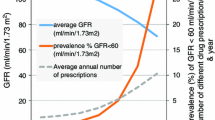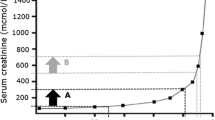Abstract
The aging process is characterized by relevant changes in pharmacokinetics. Renal function is known to decline with aging. However, as a result of reduced muscle mass, older individuals frequently have a depressed glomerular filtration rate (GFR) despite normal serum creatinine, and such a concealed renal insufficiency may impact significantly on the clearance of hydrosoluble drugs, as well as the risk of adverse drug reactions (ADRs) from hydrosoluble drugs. The assessment of renal function should thus be a mandatory item in the global examination of patient characteristics. Equations for estimatingGFR have become very popular in recent years. However, different equations may yield significantly different estimated glomerular filtration rate (eGFR) values, which have important implications in dosing drugs cleared by the kidney. Current knowledge suggests that eGFR based on the Chronic Kidney Disease-Epidemiological Collaboration (CKD-EPI) study equation outperformed eGFR based on the Modification of Diet in Renal Disease (MDRD) study equation and creatinine clearance estimate based on the Cockcroft-Gault formula as a predictor of ADRs from kidney cleared drugs. More recently, the combined creatinine-cystatin C equation was shown to perform better than equations based on either of these markers alone in diagnosing CKD, even in older patients. However, its accuracy in predicting ADRs and usefulness in drug dosing is still to be investigated.
Similar content being viewed by others
References
Inouye SK, Studenski S, Tinetti ME, et al. Geriatric syndromes: clinical, research, and policy implications of a core geriatric concept. J Am Geriatr Soc 2007 May; 55 (5): 780–91
Lee PG, Cigolle C, Blaum C. The co-occurrence of chronic diseases and geriatric syndromes: the health and retirement study. J Am Geriatr Soc 2009 Mar; 57 (3): 511–6
Cesari M, Onder G, Russo A, et al. Comorbidity and physical function: results from the aging and longevity study in the Sirente geographic area (ilSIRENTE study). Gerontology 2006; 52 (1): 24–32
Wolff JL, Starfield B, Anderson G. Prevalence, expenditures, and complications of multiple chronic conditions in the elderly. Arch Intern Med 2002 Nov 11; 162 (20): 2269–76
Onder G, Lattanzio F, Battaglia M, et al. The risk of adverse drug reactions in older patients: beyond drug metabolism. Curr Drug Metab 2011 Sep; 12 (7): 647–51
Fusco D, Lattanzio F, Tosato M, et al. Development of CRIteria to assess appropriate Medication use among Elderly complex patients (CRIME) project: rationale and methodology. Drugs Aging 2009 Dec; 26 Suppl. 1: 3–13
Olivier P, Bertrand L, Tubery M, et al. Hospitalizations because of adverse drug reactions in elderly patients admitted through the emergency department: a prospective survey. Drugs Aging 2009; 26 (6): 475–82
Zhang M, Holman CD, Price SD, et al. Comorbidity and repeat admission to hospital for adverse drug reactions in older adults: retrospective cohort study. BMJ 2009; 338: a2752
Onder G, Pedone C, Landi F, et al. Adverse drug reactions as cause of hospital admissions: results from the Italian Group of Pharmacoepidemiology in the Elderly (GIFA). J Am Geriatr Soc 2002 Dec; 50 (12): 1962–8
Tulner LR, Frankfort SV, Gijsen GJ, et al. Drug-drug interactions in a geriatric outpatient cohort: prevalence and relevance. Drugs Aging 2008; 25 (4): 343–55
Becker ML, Visser LE, van Gelder T, et al. Increasing exposure to drug-drug interactions between 1992 and 2005 in people aged > or = 55 years. Drugs Aging 2008; 25 (2): 145–52
Corsonello A, Pedone C, Incalzi RA. Age-related pharmacokinetic and pharmacodynamic changes and related risk of adverse drug reactions. CurrMed Chem 2010; 17 (6): 571–84
Shi S, Klotz U. Age-related changes in pharmacokinetics. Curr Drug Metab 2011 Sep; 12 (7): 601–10
Trifiro G, Spina E. Age-related changes in pharmacodynamics: focus on drugs acting on central nervous and cardiovascular systems. Curr Drug Metab 2011 Sep; 12 (7): 611–20
Lindeman RD. Assessment of renal function in the old. Special considerations. Clin Lab Med 1993 Mar; 13 (1): 269–77
Fliser D, Franek E, Ritz E. Renal function in the elderly — is the dogma of an inexorable decline of renal function correct? Nephrol Dial Transplant 1997 Aug; 12 (8): 1553–5
Sokoll LJ, Russell RM, Sadowski JA, et al. Establishment of creatinine clearance reference values for older women. Clin Chem 1994 Dec; 40 (12): 2276–81
Fliser D, Franek E, Joest M, et al. Renal function in the elderly: impact of hypertension and cardiac function. Kidney Int 1997 Apr; 51 (4): 1196–204
Beck LH. Changes in renal function with aging. Clin Geriatr Med 1998 May; 14 (2): 199–209
Miletic D, Fuckar Z, Sustic A, et al. Sonographic measurement of absolute and relative renal length in adults. J Clin Ultrasound 1998 May; 26 (4): 185–9
Fuiano G, Sund S, Mazza G, et al. Renal hemodynamic response to maximal vasodilating stimulus in healthy older subjects. Kidney Int 2001 Mar; 59 (3): 1052–8
Melk A, Halloran PF. Cell senescence and its implications for nephrology. J Am Soc Nephrol 2001 Feb; 12 (2): 385–93
Neugarten J, Gallo G, Silbiger S, et al. Glomerulosclerosis in aging humans is not influenced by gender. Am J Kidney Dis 1999 Nov; 34 (5): 884–8
Turnheim K. When drug therapy gets old: pharmacokinetics and pharmacodynamics in the elderly. Exp Gerontol 2003 Aug; 38 (8): 843–53
Davies DF, Shock NW. Age changes in glomerular filtration rate, effective renal plasma flow, and tubular excretory capacity in adultmales. J Clin Invest 1950 May; 29 (5): 496–507
Hollenberg NK, Rivera A, Meinking T, et al. Age, renal perfusion and function in island-dwelling indigenous Kuna Amerinds of Panama. Nephron 1999 Jun; 82 (2): 131–8
Fliser D, Ritz E. Serum cystatin C concentration as a marker of renal dysfunction in the elderly. Am J Kidney Dis 2001 Jan; 37 (1): 79–83
Lindeman RD, Tobin J, Shock NW. Longitudinal studies on the rate of decline in renal function with age. J Am Geriatr Soc 1985 Apr; 33 (4): 278–85
Coresh J, Selvin E, Stevens LA, et al. Prevalence of chronic kidney disease in the United States. JAMA 2007 Nov 7; 298 (17): 2038–47
Heuberger RA, Caudell K. Polypharmacy and nutritional status in older adults: a cross-sectional study. Drugs Aging 2011 Apr 1; 28 (4): 315–23
Linjakumpu T, Hartikainen S, Klaukka T, et al. Use of medications and polypharmacy are increasing among the elderly. J Clin Epidemiol 2002 Aug; 55 (8): 809–17
Kappel J, Calissi P. Nephrology: 3. Safe drug prescribing for patients with renal insufficiency. CMAJ 2002 Feb 19; 166 (4): 473–7
Gabardi S, Abramson S. Drug dosing in chronic kidney disease. Med Clin North Am 2005 May; 89 (3): 649–87
Hassan Y, Al-Ramahi R, Abd Aziz N, et al. Drug use and dosing in chronic kidney disease. Ann Acad Med Singapore 2009 Dec; 38 (12): 1095–103
Pillans PI, Landsberg PG, Fleming AM, et al. Evaluation of dosage adjustment in patients with renal impairment. Intern Med J 2003 Jan–Feb; 33 (1–2): 10–3
Yap C, Dunham D, Thompson J, et al. Medication dosing errors for patients with renal insufficiency in ambulatory care. Jt Comm J Qual Patient Saf 2005 Sep; 31 (9): 514–21
Onder G, Petrovic M, Tangiisuran B, et al. Development and validation of a score to assess risk of adverse drug reactions among in-hospital patients 65 years or older: the GerontoNet ADR risk score. Arch Intern Med 2010 Jul 12; 170 (13): 1142–8
Corsonello A, Pedone C, Lattanzio F, et al. Association between glomerular filtration rate and adverse drug reactions in elderly hospitalized patients: the role of the estimating equation. Drugs Aging 2011 May 1; 28 (5): 379–90
Gurwitz JH, Field TS, Harrold LR, et al. Incidence and preventability of adverse drug events among older persons in the ambulatory setting. JAMA 2003 Mar 5; 289 (9): 1107–16
Pirmohamed M, James S, Meakin S, et al. Adverse drug reactions as cause of admission to hospital: prospective analysis of 18 820 patients. BMJ 2004 Jul 3; 329 (7456): 15–9
Inker LA, Schmid CH, Tighiouart H, et al. Estimating glomerular filtration rate from serum creatinine and cystatin C. N Engl J Med 2012 Jul 5; 367 (1): 20–9
Kilbride HS, Stevens PE, Eaglestone G, et al. Accuracy of the MDRD (Modification of Diet in Renal Disease) Study and CKD-EPI (CKD Epidemiology Collaboration) equations for estimation of GFR in the elderly. Am J Kidney Dis 2012 Aug 11. [Epub ahead of print]
Cockcroft DW, Gault MH. Prediction of creatinine clearance from serum creatinine. Nephron 1976; 16 (1): 31–41
Levey AS, Bosch JP, Lewis JB, et al. A more accurate method to estimate glomerular filtration rate from serum creatinine: a new prediction equation. Modification of Diet in Renal Disease Study Group. Ann Intern Med 1999 Mar 16; 130 (6): 461–70
Levey AS, Stevens LA, Schmid CH, et al. A new equation to estimate glomerular filtration rate. Ann Intern Med 2009 May 5; 150 (9): 604–12
Corsonello A, Pedone C, Lattanzio F, et al. Does concealed chronic kidney disease predict survival of older patients discharged from acute care hospitals? Rejuvenation Res 2010 Oct; 13 (5): 539–45
Swedko PJ, Clark HD, Paramsothy K, et al. Serum creatinine is an inadequate screening test for renal failure in elderly patients. Arch Intern Med 2003 Feb 10; 163 (3): 356–60
Fielding RA, Vellas B, Evans WJ, et al. Sarcopenia: an undiagnosed condition in older adults. Current consensus definition: prevalence, etiology, and consequences. International Working Group on Sarcopenia. J Am Med Dir Assoc 2011 May; 12 (4): 249–56
Rolland Y, Czerwinski S, Abellan van Kan G, et al. Sarcopenia: its assessment, etiology, pathogenesis, consequences and future perspectives. J Nutr Health Aging 2008 Aug–Sep; 12 (7): 433–50
Jonville-Bera AP, Paroux L, Autret-Leca E. Assessing general practitioners’ prescribing behaviour in elderly patients with concealed renal failure. Br J Clin Pharmacol 2008 Jun; 65 (6): 961–3
Corsonello A, Pedone C, Corica F, et al. Concealed renal insufficiency and adverse drug reactions in elderly hospitalized patients. Arch Intern Med 2005 Apr 11; 165 (7): 790–5
Corsonello A, Pedone C, Corica F, et al. Concealed renal failure and adverse drug reactions in older patients with type 2 diabetes mellitus. J Gerontol A Biol Sci Med Sci 2005 Sep; 60 (9): 1147–51
Pedone C, Corsonello A, Incalzi RA. Estimating renal function in older people: a comparison of three formulas. Age Ageing 2006 Mar; 35 (2): 121–6
Hudson JQ, Nyman HA. Use of estimated glomerular filtration rate for drug dosing in the chronic kidney disease patient. Curr Opin Nephrol Hypertens 2011 Sep; 20 (5): 482–91
Stevens LA, Nolin TD, Richardson MM, et al. Comparison of drug dosing recommendations based on measured GFR and kidney function estimating equations. Am J Kidney Dis 2009 Jul; 54 (1): 33–42
Corsonello A, Pedone C, Lattanzio F, et al. Agreement between equations estimating glomerular filtration rate in elderly nursing home residents and in hospitalised patients: implications for drug dosing. Age Ageing 2011 Sep; 40 (5): 583–9
Stevens LA, Coresh J, Greene T, et al. Assessing kidney function-measured and estimated glomerular filtration rate. N Engl J Med 2006 Jun 8; 354 (23): 2473–83
Pedone C, Semeraro R, Chiurco D, et al. Reliability of equations to estimate glomerular filtration rate in the very old. Aging Clin Exp Res 2008 Dec; 20 (6): 496–502
Corsonello A, Lattanzio F, Incalzi RA. Estimating glomerular filtration rate. N Engl J Med 2012 Sep 27; 367 (13): 1261; author reply 3–4
Macdonald J, Marcora S, Jibani M, et al. GFR estimation using cystatin C is not independent of body composition. Am J Kidney Dis 2006 Nov; 48 (5): 712–9
Long CL, Raebel MA, Price DW, et al. Compliance with dosing guidelines in patients with chronic kidney disease. Ann Pharmacother 2004 May; 38 (5): 853–8
Geara AS, Azzi N, Ghimire P, et al. The impact of reporting estimated glomerular filtration rate. Ren Fail 2011; 33 (5): 486–8
Author information
Authors and Affiliations
Corresponding author
Rights and permissions
About this article
Cite this article
Corsonello, A., Onder, G., Bustacchini, S. et al. Estimating Renal Function to Reduce the Risk of Adverse Drug Reactions. Drug Saf 35 (Suppl 1), 47–54 (2012). https://doi.org/10.1007/BF03319102
Published:
Issue Date:
DOI: https://doi.org/10.1007/BF03319102




